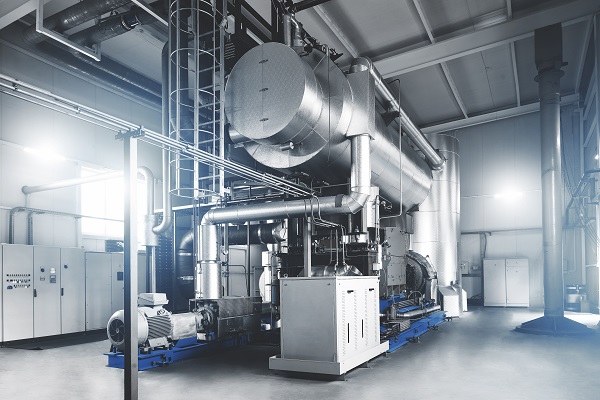Our Application Spotlight series focuses on interesting and noteworthy functions for which our heat exchangers are used. For this post, we’ll take a look at how heat is recovered during the incineration of dewatered waste solids that are separated from waste water during the treatment process. We’ll look at:
- Background on the incineration process
- Uses for recovered heat and overall benefits
- Coil design in incineration plant waste heat recovery (WHR) systems
Background on the Incineration Process
Once the solid waste materials have been extracted from the water to be treated, one place it can end up is an incinerator, which are often located on-site. More information about how the incineration process works is below.
Step 1: Waste arrives at the incinerator in the form of sewage sludge, which is the somewhat solid material extracted from the waste water (also known as effluent). It’s still very wet – not much good for burning, so step one is dewatering the mixture.
Step 2: After dewatering, the sludge is about 25% dry, at which point it’s sent to a dryer, which removes ~60% of the remaining water via evaporation.
Step 3: The solid waste is now roughly 90% dry and is ready for incineration. Typically, either multiple-hearth incinerators or fluidized bed incinerators are used. For this post, we’ll focus on the former.
After the waste’s moisture has been sufficiently reduced, the actual incineration starts. Multiple hearth incinerators, also called multi-hearth furnaces (MHF), are oriented vertically and feature four distinct zones, each serving its own function.[1] They are (from top to bottom):
- Drying
- Pyrolysis and flame combustion
- Fixed carbon burning
- Ash cooling
The dewatered solids, also known as cake, enter the MHF at the top, where it’s dried and burned. The process yields primarily dry ash and flue gas, the latter of which is sent back up through the stack as exhaust gas.
In older incinerator designs, afterburners are used to ensure complete combustion of the cake. Used as an emissions control measure, the afterburner’s function is to ensure that VOCs and other potentially harmful substances have been burned off the exhaust stream before it’s sent up through and out of the stack.
However, such afterburners consume significant amounts of natural gas, and in the years since, many facilities have upgraded their incinerator’s burners. Natural gas burner technology has advanced to a point where afterburners are no longer needed to ensure complete combustion. So, when facility managers upgrade their burners, the largely empty afterburner chamber becomes underutilized plant space.
Uses for Recovered Heat and Overall Benefits
In some cases, these old afterburner chambers can be repurposed to allow for installation of waste heat recovery heat exchangers.
High to medium temperature waste heat which is typically exhausted can be recovered to heat other processes or it can be converted to electricity by way of an Organic Rankine Cycle (ORC) turbine, like the example pictured below.
In an ORC heat recovery system, heat cascades from the gas stream, to a thermal oil, then to a two-phase working fluid which is expanded in the turbine. This expansion rotates the turbine and connected generator set. Heat recovery coils are employed to transfer waste energy from the gas stream to the thermal oil. Adoption of ORC systems in waste incineration has been anemic in the U.S., but they’re very popular in Europe, oftentimes made by the manufacturer Turboden.
ORC systems like these can lead to significant efficiency gains. Depending on the temperatures involved, thermal energy recovery on the scale of megawatts is possible. That power can then be used to offset the amount of grid power needed for plant operations.
Coil Design in Incineration Plant WHR Systems
Incineration facilities are ingenious feats of engineering, but they are really, really hot and really, really dirty. Consequently, the WHR coils used therein need to be designed accordingly, with considerations made for:
- Corrosives: Sludge incineration generates significant quantities of pollutants. Exhaust gas leaving the MHI contains particulate matter, metals, NOx, SO2, and other contaminants, so design considerations for corrosion protection are crucial. Because of that we’ll typically construct these coils from stainless steel.
- High temperatures: The high temperatures involved in this application (sometimes as high as 1200°F) precludes the usage of more common stainless steels like 304L and 316L. At such high temperatures, carbide accumulation along the material’s grain boundaries causes the steel’s chromium to migrate to those carbide sites, altering its molecular composition and negating its corrosion resistance.
To mitigate this material degradation, we will opt for steels with more applicable metallurgy, such as 321 stainless, which features the addition of titanium or 347 stainless, which has added columbium (sometimes known as niobium).
- Heavy fouling potential: Airstreams at waste incineration facilities tend to contain high amounts of particulate matter resulting from the burning process. To prevent the WHR coils from fouling and losing effectiveness, we give special consideration to the type of heat transfer surfaces used in these applications. Designs with higher fouling resistance allow for longer durations between cleanings.
In addition to fouling management, cleanability of the WHR coil is made easier with features such as slide-out designs that allow the coil to be removed without major disassembly. Additionally, WHR heat exchangers be designed to accommodate online cleaning measures such as soot blowers.
If you’re a waste incinerator facility manager who’s considering adding a WHR function to your plants or if you’re undertaking a burner upgrade, give one of our waste heat recovery experts a call. We’d love to learn more about your application.
And check out the links below for some more articles from our Application Spotlight series.
Don’t get left out in the cold when it comes to heat transfer information. To stay up to date on a variety of topics on the subject, subscribe to The Super Blog, our technical blog, Doctor's Orders, and follow us on LinkedIn, Twitter, and YouTube.
[1] Source: “Overview of Thermal Reduction Advances and DELCORA Case Study: Chilson Stanley, GHD”



